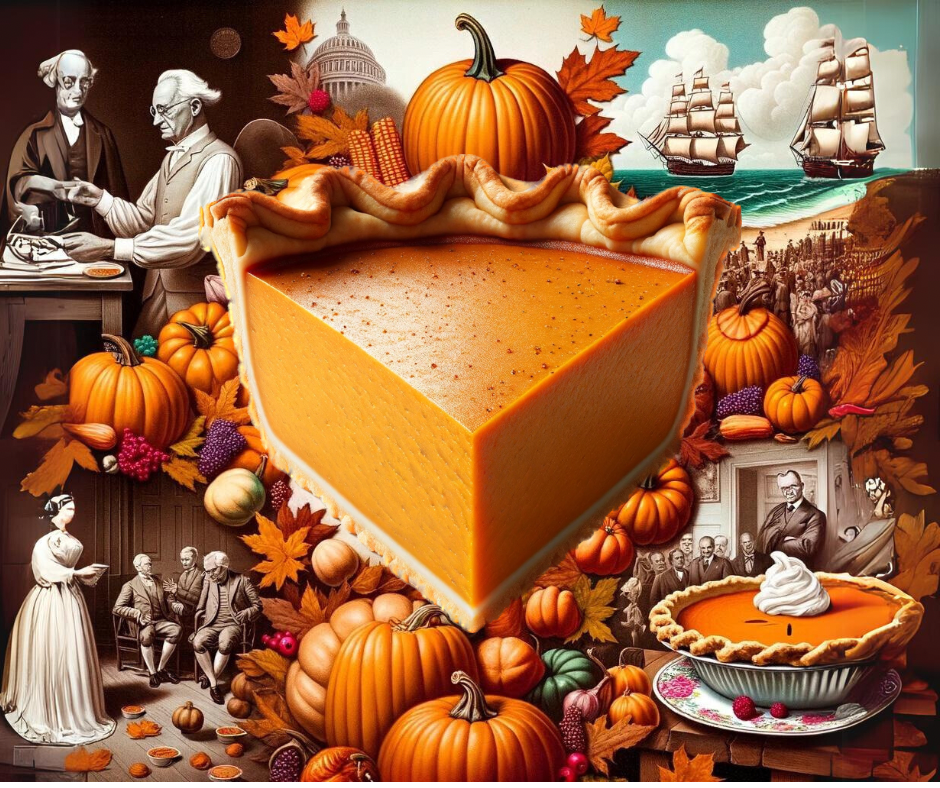
Ah, pumpkin pie! The mere mention of this quintessential holiday treat evokes a sense of nostalgia, warmth, and the comforting embrace of family gatherings. But have you ever wondered how this iconic dessert came to grace our tables? Buckle up, because we’re about to embark on a delicious journey through time to uncover the fascinating history of pumpkin pie.
The Humble Beginnings
The story of pumpkin pie begins not with the pie we know today, but with a rudimentary concoction made by early settlers in New England. These pioneers would hollow out pumpkins, fill them with milk, honey, and spices, and then bake them in hot ashes. This was a far cry from the creamy, spiced custard we associate with pumpkin pie today, but it was a start(1).
The Culinary Evolution
The first published pumpkin pie recipe in the United States appeared in Amelia Simmons’ cookbook ‘American Cookery’ in 1796. This groundbreaking cookbook featured not one, but two variations of pumpkin pie recipes, marking a significant milestone in the pie’s culinary evolution(2)(3).
The Literary Connection

By the 18th century, pumpkin pie had become a cherished part of Thanksgiving, especially in New England. Its association with the holiday was further solidified through literature. Abolitionist Sarah Josepha Hale mentioned pumpkin pie in her 1827 anti-slavery novel ‘Northwood,’ while Lydia Maria Child celebrated it in her famous 1842 poem about a New England Thanksgiving(4).
The Great Pumpkin vs. Squash Debate
Now, let’s address the elephant in the room: Is pumpkin pie filling made from pumpkin or squash? According to the FDA’s broad definition, “pumpkin” can refer to several varieties of winter squash. However, the canned pumpkin pie filling, such as LIBBY’S®, is made from a specific variety called Dickinson pumpkin. This variety is more squash-like but is indeed a type of pumpkin, putting to rest the debate once and for all(5).
The Rise of LIBBY’S®
Speaking of LIBBY’S®, how did this brand become synonymous with pumpkin pie? Well, LIBBY’S® started using the Select Dickinson Pumpkin variety of C. moschata for its canned pumpkins. This variety is tan in color, elongated, and has a richer, sweeter flavor compared to the classic orange pumpkins. This unique choice set LIBBY’S® apart and helped it dominate the canned pumpkin market.
The Southern Resistance
Interestingly, pumpkin pie faced resistance in the Southern states after the Civil War. It was seen as a symbol of Yankee culture imposed on the South, where there was no tradition of eating pumpkin pie. Southern cooks instead opted for sweet potato pie or added bourbon and pecans to give the pumpkin pie a Southern touch.
The Truman Thanksgiving Controversy
In 1947, pumpkin pies were discouraged from Thanksgiving dinners in the United States as part of a voluntary egg rationing campaign promoted by the Truman Administration. This led to considerable backlash among American consumers, and no pumpkin pie was served at the White House for Thanksgiving in 1947.
Conclusion
From its humble beginnings as a pumpkin filled with milk and spices to its current status as a holiday staple, the pumpkin pie has undergone a fascinating evolution. It’s a testament to human ingenuity, adaptability, and the unifying power of food. So the next time you dig into a slice of pumpkin pie, remember, you’re not just enjoying a dessert; you’re partaking in a rich, delicious history.
References
- https://www.history.com
- https://www.eatingtheworld.com
- https://www.backthenhistory.com
- https://www.culturetrip.com
- https://en.wikipedia.org/wiki/Pumpkin_pie









